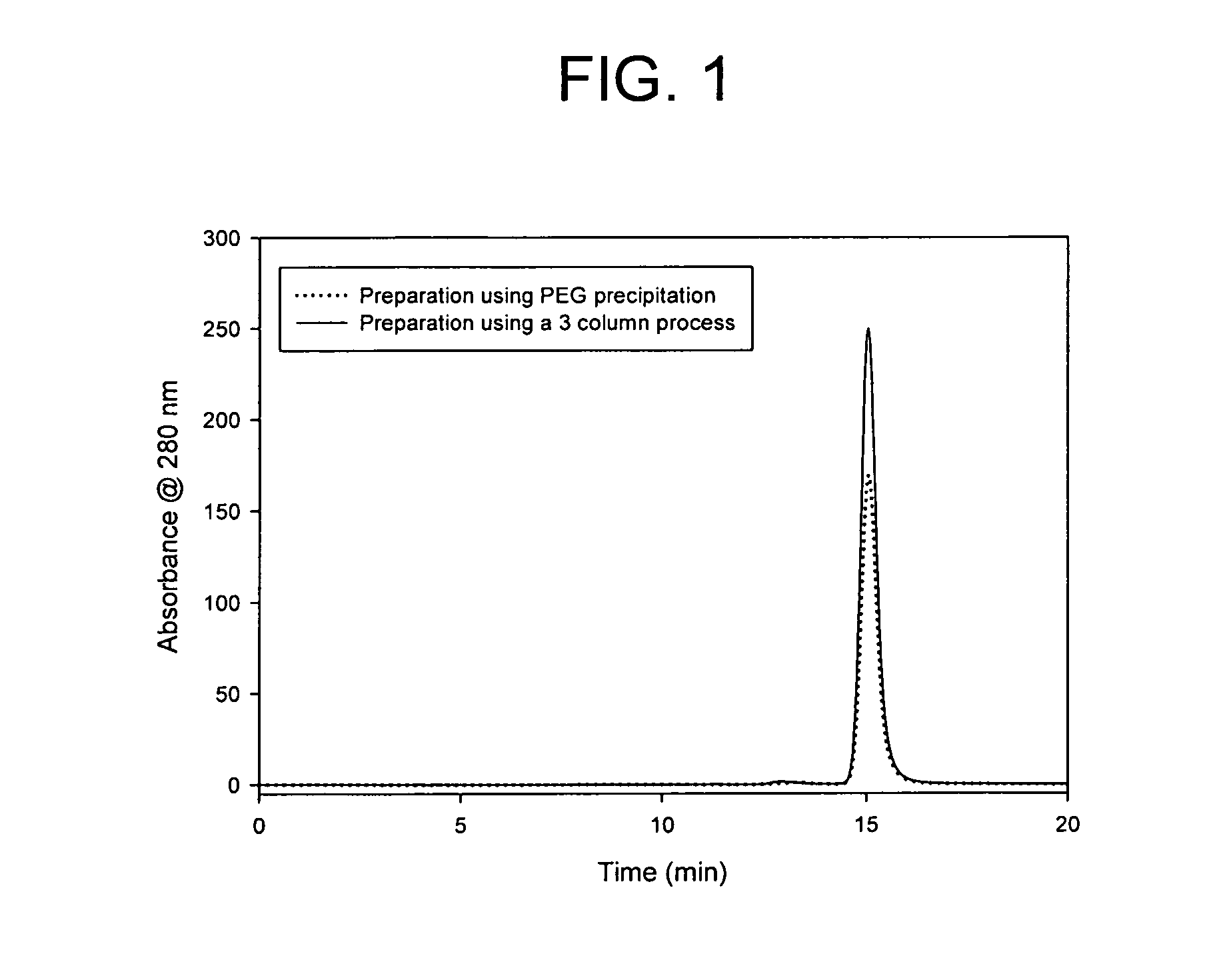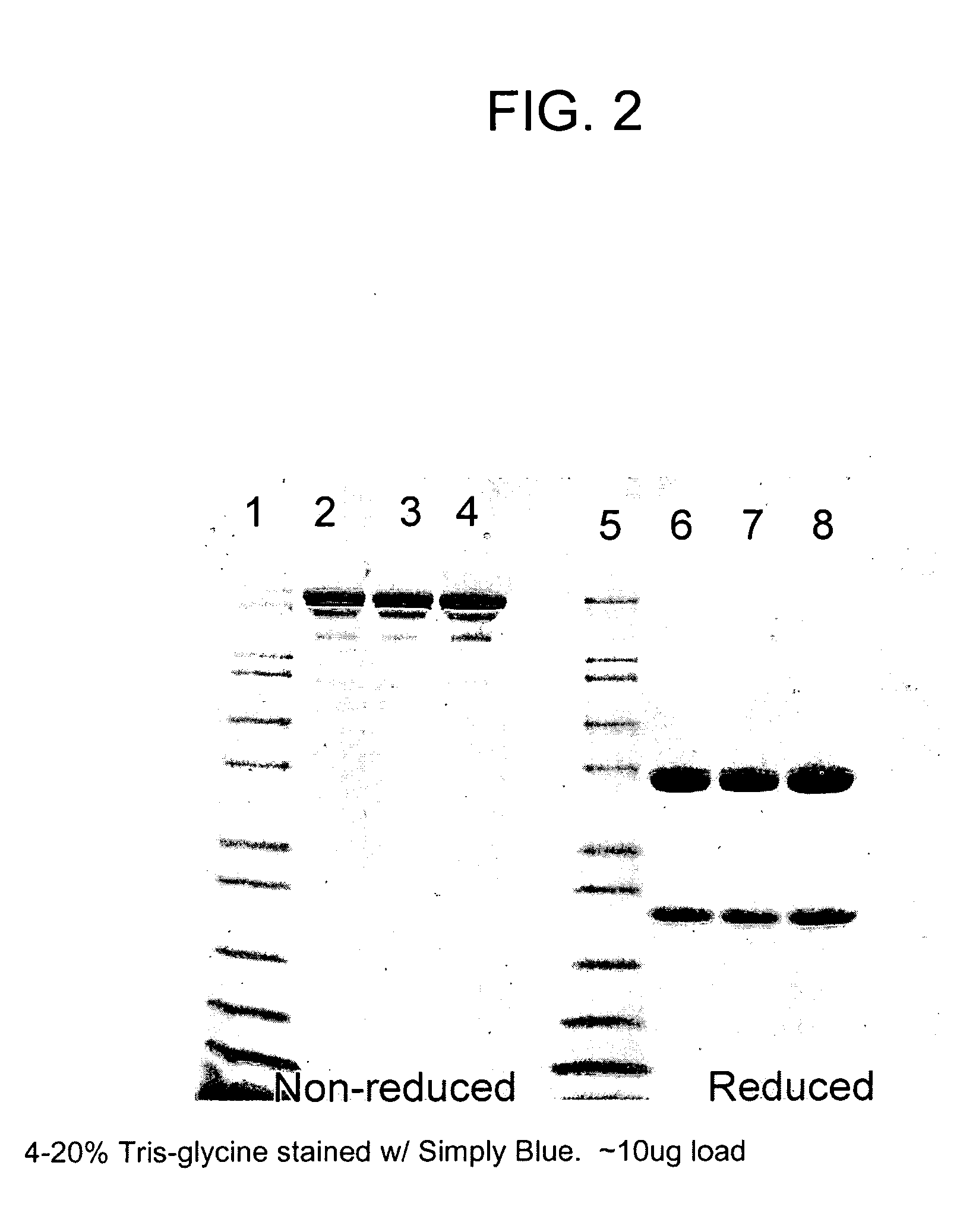Method of isolating antibodies by precipitation
a technology of precipitation and antibody, which is applied in the field of isolating antibodies by precipitation, can solve the problems of high titer, consuming time and resources, and affecting the quality of antibody precipitation, so as to remove any potential bacterial contamination and preserve the sterility of the solution
- Summary
- Abstract
- Description
- Claims
- Application Information
AI Technical Summary
Benefits of technology
Problems solved by technology
Method used
Image
Examples
example 1
Isolation of MAbs by PEG Precipitation and Two Chromatography Steps
[0054]Cell culture media containing MAb was harvested using a combination of centrifugation, depth filtration and membrane filtration. The cell debris-free media, henceforth referred to herein as “clarified cell culture media,” was then stored at 2-8° C. until the initiation of the precipitation step.
[0055]A 37.5% (w / v) stock solution of polyethylene glycol 6000 (PEG 6000) (Alfa Aesar, Ward Hill, Mass., USA) was added to the clarified cell culture media to produce a PEG 6000 concentration of 10% (w / v) in the final suspension. The suspension was mixed completely for a minimum of 30 minutes. The temperature during the mixing was maintained at 2-8° C. After the completion of the precipitation, the IgG rich precipitate was separated from the supernatant using a centrifuge operating at 3000 g, or by filtration. The supernatant was discarded. The antibody-containing precipitate can be stored and used after the PEG precipit...
example 2
Isolation of MAbs by PEG Precipitation, Two Chromatography Steps and a Viral Kill Step
[0060]Cell culture media containing MAb antibodies was harvested using a combination of centrifugation, depth filtration and membrane filtration. The cell debris-free media, henceforth referred to herein as “clarified cell culture media,” was then stored at 2-8° C. until the initiation of the precipitation step.
[0061]A 37.5% (w / v) stock solution of polyethylene glycol 6000 (PEG 6000) (Alfa Aesar, Ward Hill, Mass., USA) was added to the clarified cell culture media to produce a PEG 6000 concentration of 10% (w / v) in the final suspension. The suspension was mixed completely for a minimum of 30 minutes. The temperature during the mixing was maintained at 2-8° C. After the completion of the precipitation, the IgG rich precipitate was separated from the supernatant using a centrifuge operating at 3000 g, or by filtration. The supernatant was discarded. The antibody-containing precipitate can be stored a...
example 3
Isolation of MAbs by PEG Precipitation, a Chromatography Step and a Membrane Chromatography Step
[0064]Cell culture media containing MAb is harvested using a combination of centrifugation, depth filtration and membrane filtration. The cell debris-free media, henceforth referred to herein as “clarified cell culture media,” is then stored at 2-8° C. until the initiation of the precipitation step.
[0065]A 37.5% (w / v) stock solution of polyethylene glycol 6000 (PEG 6000) (Alfa Aesar, Ward Hill, Mass., USA) is added to the clarified cell culture media to produce a PEG 6000 concentration of 10% (w / v) in the final suspension. The suspension is mixed completely for a minimum of 30 minutes. The temperature during the mixing is maintained at 2-8° C. After the completion of the precipitation, the IgG rich precipitate is separated from the supernatant using a centrifuge operating at 3000 g, or by filtration. The supernatant is discarded. The antibody-containing precipitate can be stored and used ...
PUM
| Property | Measurement | Unit |
|---|---|---|
| temperature | aaaaa | aaaaa |
| temperature | aaaaa | aaaaa |
| temperature | aaaaa | aaaaa |
Abstract
Description
Claims
Application Information
 Login to View More
Login to View More - R&D
- Intellectual Property
- Life Sciences
- Materials
- Tech Scout
- Unparalleled Data Quality
- Higher Quality Content
- 60% Fewer Hallucinations
Browse by: Latest US Patents, China's latest patents, Technical Efficacy Thesaurus, Application Domain, Technology Topic, Popular Technical Reports.
© 2025 PatSnap. All rights reserved.Legal|Privacy policy|Modern Slavery Act Transparency Statement|Sitemap|About US| Contact US: help@patsnap.com



